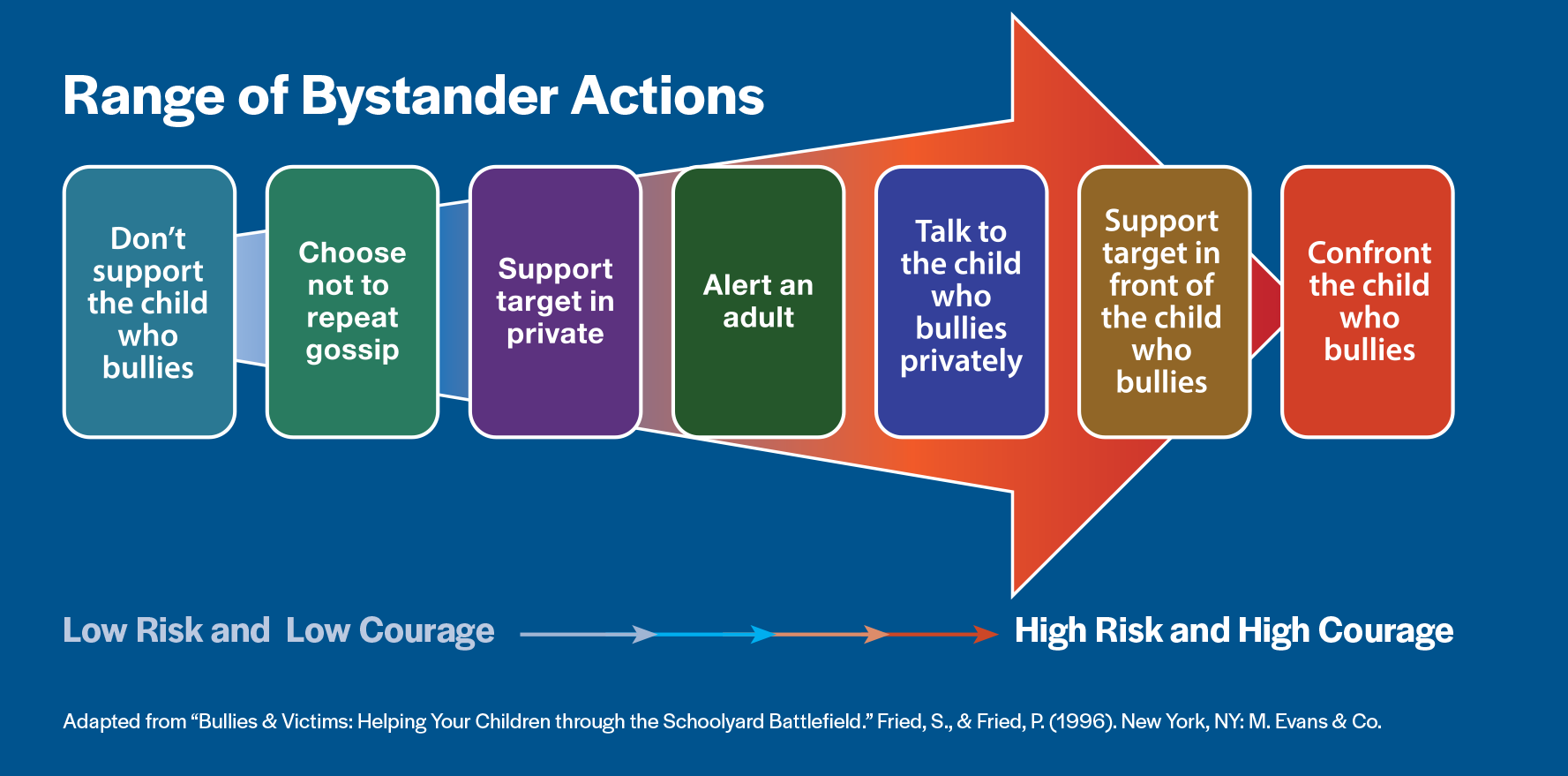
Children Who Bully Others
Sometimes parents must deal with situations in which their children have behaved in a way that is mean and hurtful to others. Parents can support children who bully to make positive behavioral changes by using the following strategies:
Discuss bullying and set clear rules at home.
It is important to have consistent, clear rules that have fair and predictable consequences. Redirect your child and provide negative consequences when your child demonstrates verbal, physical, electronic or relational aggression directed at another child. Praise your child when he or she chooses not to participate in bullying behavior or when he or she helps a student who is being bullied.
Talk with your child.
Ask for your child’s account of the anti-bullying incident. Be prepared to be objective and to listen carefully. Explain your understanding of the bullying incident. Clearly communicate that this type of behavior is serious and will not be tolerated.
Understand bullying policies and work with the school.
All parents should be informed of the school’s bullying policy and procedures. If your child is involved in bullying at school, be prepared to support the school’s actions. You may wish to set up a schedule of regular meetings with school staff to gain feedback on how your child is responding to any interventions to address peer aggression.
Help your child connect with peers who demonstrate positive behavior.
Peers can serve as positive role models for children and are important players in the bullying dynamic.
Model the behavior you expect from your child.
Show respect to others. Solve problems without aggression. Set a good example for your child.
Children Who are Bullied at School
Because students are in school for most of the day, children are more likely to be bullied at school than anywhere else. In addition to providing support to their children, parents should work with the school to ensure educators are aware of bullying issues and responsive to students’ needs by using these strategies:
Be proactive.
Parents and educators should work together, through Parent-Teacher Organizations or other task forces, to develop and implement effective bullying prevention and intervention strategies.
Know your school’s policies.
It is important to be familiar with the policies and procedures that your school employs. All states have some laws or guidelines to implement bullying prevention strategies in schools.
Communicate with school staff.
If your child is the target of bullying, you will need to work with teachers and administrators at the school to implement strategies to end the bullying and prevent retaliation. If the school seems unresponsive to your reports, write a letter that formally requests an investigation and follow-up.
Talk with your child.
Explain what bullying is and why it is wrong. If your child reports bullying to you, praise them for having the courage to share the bullying incident with you. Let your child know that you are interested in supporting and helping them. Show your child empathy and encourage them to share thoughts and feelings about the bullying. Emphasize that you are sorry this happened, and no one deserves to be mistreated.
Document and report continued bullying.
Keep a log or journal based on information communicated to you from your child. Review the log regularly for frequency, severity and consistency, and share with supervising adults at school. Work with others to increase adult supervision of your child, especially at those times and in those places where you know bullying incidents have occurred. If the bullying escalates and your child is injured physically or emotionally, you may want to visit a doctor to have the injuries formally recorded. You should notify authorities if you suspect bullying crosses the line into criminal activity.
If your child talks about suicide or seems unusually upset, seek help immediately.
Contact your physician or a mental health provider and request an evaluation. If professionals are not immediately available, call the National Suicide Prevention Lifeline at 988.
Identify an adult at your child’s school who has a connection with your child.
This adult can help your child feel safe at school by listening to your child, encouraging your child and receiving reports of suspected bullying. A trusted adult may also check in with your child on a regular basis and communicate with other adults in the school to promote more effective supervision and intervention. Parents may request that the school help them identify this type of support person as part of planning for their child’s safety at school.
Encourage problem-solving for safety.
While adults and other bystanders should intervene to stop bullying, this does not always happen. Therefore, it is important that children plan for their safety and develop an array of possible responses to bullying. Encourage the child who is bullied to identify safe peers, avoid the student(s) who are bullying as much as possible, and inform adults of bullying that has occurred. Children may benefit from identifying possible responses to bullying, in advance of a bullying incident.
Respond to questions like, “Why did they do that to me?” with reassurances to your child.
Start with “I’m sorry this happened to you.” A simple answer to this common question is that “some people are mean to others” or “maybe he or she was having a bad day.” Do not give answers that may encourage your child to blame himself or herself.
Keep open communication with your child.
Check in with your child regularly to see how things are going. Ask about their social relationships and if the situation has improved. Bullying incidents may not be resolved quickly, and your child will benefit from your continued support.
Help your child connect with other children and develop new friendships.
Encourage your child to participate in activities that they enjoy and create opportunities for your child to spend time with children who share their interests. Supportive and positive peer relationships are important to your child’s development.
If You Suspect Your Child is Being Bullied

Do not blame
your child.

Do not tell your child to ignore it.

Do not tell your child to retaliate.

Do not expect your child to work it out alone.

Do not allow mediation, if the child is reluctant or a parent or trusted adult is not present.

Do not demand apologies.
Ways to Help Children Who Witness Bullying
It is very likely that your child has observed a bullying incident while at school or in the neighborhood. Bystanders, while not directly involved in bullying, can be negatively impacted by these encounters. They may feel anxious about what they witnessed, worried about the child who is bullied, or ambivalent about how to respond. Your response can help your child recognize that bullying is a serious problem and can empower your child to become an ally to children who are bullied.
If your child reports that they observed bullying, listen carefully to the description of what occurred. Be on the lookout for escalating negative behaviors or increasingly violent behaviors against one child and report this to the school.
Establishing positive communication is key to supporting young people. This includes being available for your child, listening to them, and responding non-judgmentally when your child shares a concern. To promote positive communication, ask your child to brainstorm possible solutions to problems before sharing your own ideas. Developing this routine in daily interactions can prepare your child to respond flexibly and effectively in problem situations.
Talking to Children Who Are Bystanders
Ask questions to discover your child’s experience with bullying at school, such as:
- What is your child’s relationship to the child who bullies and the target?
- What do your child’s friends think and do about bullying?
- What does your child think they should do?
Reflect on your child’s feelings. Consider what issues may be influencing your child and the choices of bystanders. Brainstorm a range of helpful bystander responses and discuss potential outcomes to different responses, and have your child identify a positive action they are willing to try.
